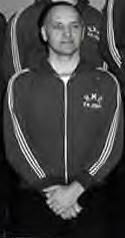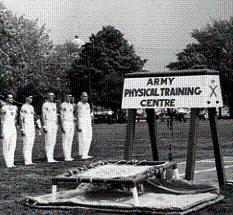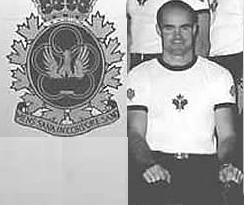
“Since I lived in civilian housing in Barriefield near highway 15, I ran back and forth across the soccer field to the College each day.”
Dennis Bradley
 Born in the UK, MWO (Ret’d) Dennis Bradley, a former member of the British Airborne Regiment, enlisted in the Princess Patricia’s Canadian Light Infantry in 1953. He transferred to PTS(RCIC) in the late 1950s. He served at Borden; Kingston; RMC; and CFSPER. An outstanding all around athlete he is an inductee in the Canadian Forces Sports Hall of Fame for outstanding achievement in Officiating (Boxing). He was awarded the OMM in 1973. Retiring in 1979 as an MWO he became the Technical Director for Boxing Ontario. Dennis is now living comfortably in Barrie ON. From 1971-1975, he was an Official – North American Championships. From 1975-1985, he was an Official – International Championships. From 1978-1981, he was Chief Referee/Judge for Canada. In 1985, he was Chief Official for Canada.
Born in the UK, MWO (Ret’d) Dennis Bradley, a former member of the British Airborne Regiment, enlisted in the Princess Patricia’s Canadian Light Infantry in 1953. He transferred to PTS(RCIC) in the late 1950s. He served at Borden; Kingston; RMC; and CFSPER. An outstanding all around athlete he is an inductee in the Canadian Forces Sports Hall of Fame for outstanding achievement in Officiating (Boxing). He was awarded the OMM in 1973. Retiring in 1979 as an MWO he became the Technical Director for Boxing Ontario. Dennis is now living comfortably in Barrie ON. From 1971-1975, he was an Official – North American Championships. From 1975-1985, he was an Official – International Championships. From 1978-1981, he was Chief Referee/Judge for Canada. In 1985, he was Chief Official for Canada.
e-veritas: How did you become a PERI?
Dennis Bradley: During the 1950s, I served in the Army as a member of the Princess Patricia’s Canadian Light Infantry (PPCLI). I was involved in boxing and soccer with PPCLI when I served in Germany from 1953-55. When I returned to Canada, I worked in the gym at CFB Edmonton 56-59. I spent four years with the Canadian Forces biathlon team, and had the opportunity to coach the team at the Olympics in Grenoble France in 1968. It was relatively easy to transfer to the physical education staff at the start up of the military physical training corps. I became qualified as an instructor at the Camp Borden School of Physical Education. There were ten people ahead of me, five of whom were qualified at the School of Physical Education in Aldershot, England. Ken Macdonald, who later served at RMC was my course supervisor at Camp Borden. A number of the Physical Education and Recreation Instructors (PERI) were later commissioned and became Physical Education and Recreation Officers (PERO). I was exposed to gymnastics at Camp Borden and was a member of a touring gymnastics team which put on an annual display at the Canadian National Exhibition (CNE) in Toronto. I recall that we preceded Bob Hope, who was the main event at the CNE that year.
e-veritas: At which Military College did you serve?
Dennis Bradley: I served as a member of the athletic staff at Royal Military College in Kingston from 1971-75. I also worked with RMC cadets while serving at Camp Borden in 1966-1970. The Royal Military College selected instructors who were certified by Camp Borden as being qualified in various sports. The cadets called me ‘Warrant’ or ‘Coach.’
e-veritas: Describe the RMC cadets` summer training at Camp Borden.
Dennis Bradley: When I was posted as an Army Physical Education Recreation Instructor in Borden (1966-70), two hundred cadets came from RMC for summer training each year. At the Military Colleges, the military instructors trained the cadets in drill and parade procedure, however there wasn’t much opportunity for the Cadets to shoot on the ranges or undergo military training. The summer program at Camp Borden consisted of basic and advanced infantry training including drill, field tactics, skill-at-arms, first aid, tactical weapon handling, shooting, and battle procedures. The cadets developed their leadership skills by working as platoon leaders with infantry platoons. To enhance mental and physical robustness, the summer program included physical education and sport events culminating in an annual track and field and swimming competition.
e-veritas: What was your schedule like at the College?
Dennis Bradley: Since I lived in civilian housing in Barriefield near highway 15, I ran back and forth across the soccer field to the College each day. From 8am-3pm, I instructed the 1, 2, 3rd and 4th year Cadets. Although I was capable of instructing all the sports at the Colleges, I specialized in a few sports: volleyball, boxing, X-Country running and X-Country skiing. Since the fourth year cadets were responsible for running and officiating the intramurals program from 4 pm until dinner, my contact with intramurals was limited to fan/spectator and running the occasional officiating clinic. It was a busy program and work-life balance wasn’t ideal for the athletic staff, particularly for those who were married. In fact, there were not too many married instructors in the program. During the summer, I took annual leave, took courses at Camp Borden, practiced gymnastics and I got ready for the new school year.
e-veritas: Did you also coach or be involved with a varsity teams? Explain.
 Dennis Bradley: I coached from 4pm until dinner during the week, with games scheduled with, for example, our cross town rivals Queens in the evenings. RMC competed in the Ontario University Conference, which consisted of the University of Toronto, University of Windsor, Guelph University, University of Ottawa, University of Waterloo etc. I drove the Cadets in a green military vehicle to away games on the weekends. On a typical weekend, we might drive to Windsor to play soccer on Saturday against the University of Windsor. On Sunday, we might drive to Kitchener play soccer against the University of Waterloo. On the weekend, the teams were generally either billeted in spare rooms at the University residence or in a hotel. In the fall, I coached soccer, X-country running. Although marksmanship was on the drill side of the program at RMC, I coached the shooting team. In the winter, I coached volleyball, boxing and X-Country skiing. The Cadets who ran and skied X-Country often practiced in the golf course at the base in Kingston or on local hiking and cross country trails. The cadets competed in touring or racing events around Kingston, the Ottawa Valley and Quebec. The RMC varsity teams competed against College Militaire Royal and Royal Roads Military College.
Dennis Bradley: I coached from 4pm until dinner during the week, with games scheduled with, for example, our cross town rivals Queens in the evenings. RMC competed in the Ontario University Conference, which consisted of the University of Toronto, University of Windsor, Guelph University, University of Ottawa, University of Waterloo etc. I drove the Cadets in a green military vehicle to away games on the weekends. On a typical weekend, we might drive to Windsor to play soccer on Saturday against the University of Windsor. On Sunday, we might drive to Kitchener play soccer against the University of Waterloo. On the weekend, the teams were generally either billeted in spare rooms at the University residence or in a hotel. In the fall, I coached soccer, X-country running. Although marksmanship was on the drill side of the program at RMC, I coached the shooting team. In the winter, I coached volleyball, boxing and X-Country skiing. The Cadets who ran and skied X-Country often practiced in the golf course at the base in Kingston or on local hiking and cross country trails. The cadets competed in touring or racing events around Kingston, the Ottawa Valley and Quebec. The RMC varsity teams competed against College Militaire Royal and Royal Roads Military College.
e-veritas: Describe the Cadet boxing program at RMC?
Dennis Bradley: The Cadets boxed in class and competed in recruit boxing tournaments. As a boxing coach, I instructed the cadets on stance, defence, punching, footwork and balance. To be a good boxer, an athlete required the desire, fitness, will to win, and determination to compete. Boxers needed to be willing to not only give but also to take a punch. The Marquis of Queensbury Rules of boxing were very strict. The Cadets wore head guards and 10 ounce gloves and competed in 3 rounds of boxing for 3 minutes. During competitions, there were 3-5 judges and a referee the outside ring. Boxers competed at boxing championships at the regimental, battalion, command, and army national level. Several Canadian amateur boxers who served in the Army made the Olympic team. Although the Army was known for the excellence of its boxing program, there were some excellent boxers in the Navy and in the Air Force.
e-veritas: Describe the staff and facilities at RMC?
Dennis Bradley: There were twelve people on the athletic staff at RMC, consisting of three Army, three Air, three Navy instructors, a Chief Warrant Officer, a Director of Athletics and a civilian football coach. My office was in a small room adjoining the old gymnasium, where I instructed. At the time, judo, wrestling, boxing and hockey were the most popular competitive sports at the College.
e-veritas: What do you consider the high-light of instructing the Cadets?
Dennis Bradley: I enjoyed dealing with cadets as a member of the athletic staff at Royal Military College in Kingston and during their summer training at Camp Borden. I found the cadets were excellent people to work with. As an instructor, the situation was ideal since the cadets wanted to participate and learn. The cadets wanted to go to the College gymnasium and did not want to leave after practice or sporting events.
e-veritas: Describe how the cadets used medicine balls?
Dennis Bradley: Every gym had medicine balls, which took the place of weights. There were 10-20 medicine balls of different sizes, which weighed 8-10 pounds each. The medicine balls were stored in the corner of the Old Gym and on the running track upstairs. Medicine balls were used in abdominal exercises, for example by hitting yourself in the stomach. A class of 15-20 Cadets might throw the medicine balls to each other. A cadet would sit facing the wall with his legs apart and throw the medicine ball against the wall 30-40 times to develop his arms and shoulders.
e-veritas: Describe a typical volleyball class in the old gym?
Dennis Bradley: The Old Gymnasium was a small facility with just enough space to put up a volleyball court. The Cadets would warm up by running around the indoor track upstairs. Although the track was only five feet wide, cadets could overtake each other running around it.
e-veritas: what are you doing these days?
Dennis Bradley: At 77 years of age, I am retired and living in Barry, Ontario. I play golf in the summer since I never had the chance to play golf in the Army. In the winter I go x-country skiing and snow shoeing. When I retired from the Army in 1978, civilian boxing was get getting started. I worked at the Amateur Boxing Association of Ontario in Toronto for fifteen years from 1978 to 1993. In fact, I was the first paid employee of the Amateur Boxing Association of Ontario. I recall the first provincial championships which were held in Barrie. As the sport grew, I served as a referee and judge at the Provincials, Nationals, Commonwealth Games, Pan American Games and at the Olympic Games.
e-veritas: Did you have a role in Cadet discipline?
Dennis Bradley: I didn’t have a role in Cadet discipline. At that point, the senior cadets were responsible for the junior cadets. I was not that involved with the Cadets other than sport. The Cadets loved playing practical jokes on each other, but they generally didn’t play them on the Athletic staff. The players occasionally threw the coach in the pool if we won an event. The cadets had a terrific attitude. The cadets wanted to be in class and they were proud to be competing in the Varsity program.
e-veritas: Did you have a role in the annual Obstacle Course?
Dennis Bradley: Yes. The Athletic staff would run the obstacle course before the cadets to make sure it was safe. I was surprised and delighted to hear that the Commandant and Director of Cadets ran the Obstacle Course in 2008. In my day, the Commandant and Director of Cadets were too old to run the annual Obstacle Course.
Dennis Bradley may be contact: 705 734-2553
Canadian Forces Sports Hall of Fame
____________________________________________________________________________________________________
“The team became strong and vibrant, competing at the OU/ OW / CIAU level thru the 1994/95 college year and for years to come after that.”
Mike Hackbart
Mike Hackbart was a high achieving PERI at RMC – in the gym and in the pool – a talented go-getter. The key to his success was a wise mix of skill and discretion.
He wanted and expected nothing less than the best from the cadets, and in return was always willing to give his best to them.
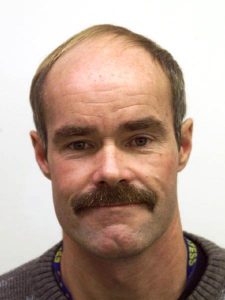 e-veritas: At which Military College did you serve?
e-veritas: At which Military College did you serve?
Mike Hackbart : I still have many very fond memories from serving in the physical education staff at the Royal Military College in Kingston – Jul 93 to Jan 97.
e-veritas: What was your primary duty? Did you also coach or be involved with a varsity team?
Mike Hackbart : I performed PERI related duties and coached for Varsity Swim Team. I had 12 years experience coaching Competitive Swimming back at that time.
e-veritas: Do you have any particular memory or short story you would like to share with our readers?
Mike Hackbart : After arriving at the College in the summer of 93 and settling in I was toured around the College by Jake Kennedy, also a PERI and the triathlon/running team coach. We headed to the pool, down stairs in Fort Haldiman to take a look at the facility. Although the pool was in a basement with no windows and was only 25 yards, vice a 25 meter regulation facility, it was in good repair and where we would train. The first Officer Cadet I had the pleasure to meet was Kimberly Baker, she was standing in the viewing area when we arrived. Kim had came to the College a year earlier from the Kitchener/Waterloo area, specifically from the ROW Swim Club. A very good and Nationally ranked civilian club. I was immediately impressed with Kim, her beaming smile and with her strong technical and competitive swimming background that she would bring to our new and growing program.
In 1993, the College was not a member of the CIAU swimming circle. The first priority – to gain momentum towards a Varsity program. This was to develop a Competitive Swim Team and compete at this level, locally. Encouragement from the Athletic Dept was to organize a team first at a College “club level” to generate interest and a core group of athletes. This was important prior to entering a team into the CIAU level of competition. Interest and the skill level was excellent in that first year so the College endorsed entering a team at the CIAU level the following season. Many, many years prior, back in the 50’s, there had been a competitive swim program at RMC but it had faded away for some reason. There it was, a competitive swim program once again at RMC and I was extremely pleased of being apart of it.
The team became strong and vibrant, competing at the OU/ OW / CIAU level thru the 1994/95 college year and for years to come after that. As an athlete juggling an academic program, in addition to committing to a Varsity team program, can be and is a very difficult thing to handle but will prepare you for other challenges later in life. In most cases it was nothing that swim team athletes had not encountered in the past because many of them had grown up from their grade school and high school years training in access of 28 hours per week ! The added pressure of Mil Col was taken in stride and over came.
It was an amazing process to see a first year grow through those four years at Mil Col ! Working with athletes such as Garrett Lawless, D’arcy Giguere, Kimberly Baker, Tanya (Stevenson), Aaron MacLuskie, Bart, Justin, Sebastien and of course the Benyon twins, Laurie and Heather to name only a few, was indeed a pleasure and one of the highlights of my swim coaching carer of 23 years. Working with other dedicated athletes in the pool such as Tony O’Keefe, was also rewarding.
e-veritas: What do you consider the high-light of serving at the Military College?
Mike Hackbart : Success can be measured in many ways. Setting a goal and working to attain that goal whatever that maybe, is one way to measure success. “I CAN” is a simple but powerful statement. There was an bulletin board at the pool in broad view where swim team athletes had placed their personal goal for that year. They saw it everyday, sometimes twice per day when training. For those achieving that goal or at least whole heartedly trying to achieve the goal, was very pleasing and satisfying from a coaching perspective.
The most rewarding high-light from working at Mil Col is the “life after” when contact is made. You know immediately if you have had a positive influence in that person’s life when they recognize you on the street and say hello or have sent you a note over the years.
e-veritas: What are you doing these days?
Mike Hackbart : I retired from Swim Coaching when the competitive swim program at CFB Trenton was eliminated in 2005. I am happily “semi- retired” in the Trenton/Belleville area, working on the base as a Public Servant at ATESS and tending our small vineyard/hobby farm at home with Deb my wife, of 28 years!
Mike may be reached: 613 477-2429 hackbart.mj@forces.gc.ca
____________________________________________________________________________________________________
“As a PERI at RMC, I was really fit. I did my own fitness training for an hour and a half over lunch consisting of running 10 km every day, weight training, push ups, chin ups and sit ups.”
Art Stevenson
Art Stevenson was one of best liked and respected PERIs on the athletic staff during his time at RMC. Whether this was because of his “down home Newfoundland wit” or because he was just an all-round easy going type of individual, it doesn’t really matter. Cadets and staff alike responded well to his personal leadership style.
He was recognized as an all-round athlete. Art played a number of sports; officiated and coached – all at the CF National level of competition.
He was not and is still not all play and no work. He has become one of the most decorated former PERI and now “PSP” employee in the system. His tours outside Canada and medals include:
Nov 76-May 77 United Nations Emergency Force-Ismailia, Egypt;
NATO Medal Germany Oct 77-Jul 79;
Jun -Dec 88 United Nations Disengagement Observing Force-Golan
Heights, Middle East;
Non-Article 5 NATO(3) as fols: Mar-Sep 2001; Sep 03-Feb 04 and Oct
-Dec 04;
The European Union Security Defense Policy Service Medal Dec 04 – Apr
05;
Canadian Peacekeeping Medal; and
C.D.
e-veritas: At which Military College did you serve?
Art Stevenson: I served on the athletic staff at RMC in Kingston from 1988-90. At the time, Major (Ret`d) Bill Oliver, who was fondly known as “Olly”, was the Athletic Director. The cadets called me Sgt. or Coach. I was responsible for instructing the Otter Squadron. My position differed from other athletic staff in that I instructed University Training Plan Non Commissioned Members (UTPNCM) cadets; individuals who have extensive prior service in the regular force as Non Commissioned Members. I ran fitness classes, and instructed sports from 8am-4pm out of the SAM Athletic Centre, which was named for 45 Sir Archibald Macdonnel. Although the cadets were known for playing skylarks on each other, I don’t remember the cadets playing any tricks on me. The cadets didn’t have a lot of spare time since they were too busy challenging themselves. As a PERI at RMC, I was really fit. I did my own fitness training for an hour and a half over lunch consisting of running 10 km every day, weight training, push ups, chin ups and sit ups.
e-veritas: What do you consider the high-light of serving at RMC?
Art Stevenson: I taught fitness classes on every posting during my career. I enjoyed instructing the cadet classes at RMC. I found the cadets to be attentive and competitive with a will to succeed. Although the classes were coed, there were a lot more male cadets then female cadets at the time. In a fitness class, for example, the cadets would challenge each other into the ground. The leadership at the College ensured that the athletic staff felt like we belonged to the team. We felt like we made a difference in future leaders in military. It was a job in which everybody cared.
e-veritas: How did you come to serve on the athletic staff at RMC?
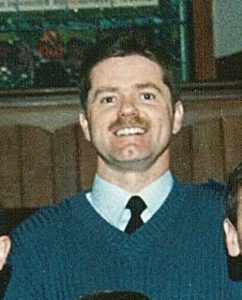 Art Stevenson: I spent the first seven years of my military career in the infantry with 3 Royal Canadian Regiment. During my tour in Germany I played on the Army hockey team in the winter and the fastball team in the summer. “Barney” Barnard, who was the Base Physical Education Recreation Officer in Baden suggested that I become a Physical Education Recreation Instructor. I loved working out and had a passion for playing hockey, fastball, broomball, tennis and golf. I thought the choice was simple; I could crawl around in the mud or run around the gym with clean shoes. In the summer of 1978, I took the PERI course at CFB Borden. I’m not really sure how I ended up at RMC from 1988-90. I lived in the Private Married Quarters in Kingston. Although I worked hard as a PERI, I didn’t really see it as work. During various postings, I have often run into the ex-cadets who I instructed. I enjoy hearing their stories and getting up to date on their adventures and accomplishments since RMC.
Art Stevenson: I spent the first seven years of my military career in the infantry with 3 Royal Canadian Regiment. During my tour in Germany I played on the Army hockey team in the winter and the fastball team in the summer. “Barney” Barnard, who was the Base Physical Education Recreation Officer in Baden suggested that I become a Physical Education Recreation Instructor. I loved working out and had a passion for playing hockey, fastball, broomball, tennis and golf. I thought the choice was simple; I could crawl around in the mud or run around the gym with clean shoes. In the summer of 1978, I took the PERI course at CFB Borden. I’m not really sure how I ended up at RMC from 1988-90. I lived in the Private Married Quarters in Kingston. Although I worked hard as a PERI, I didn’t really see it as work. During various postings, I have often run into the ex-cadets who I instructed. I enjoy hearing their stories and getting up to date on their adventures and accomplishments since RMC.
e-veritas: Are you still involved with the CF?
Art Stevenson: After RMC, I was posted home to St John’s Newfoundland from 1990-’92. I was then posted across the country from 1992-‘5 at Vancouver detachment Chilliwack. I was posted back to Gander Newfoundland from 1995-April ’97. When the PERI trade disbanded, I retired from the Canadian Forces and worked as a sports, fitness and recreation coordinator as a civilian for Canadian Forces Personnel Support Agency from April 1997-September 1999. In September 1999, I became a facility coordinator at CFB Gagetown.
My wife Diane and I live in Oromocto, New Brunswick with our 2 beautiful children Hannah and Lucas. To stay fit, I work out over lunch and play golf whenever I can.
e-veritas: I understand you were an athletic facility coordinator at RMC as a secondary duty.
Art Stevenson: Yes. I was responsible for coordinating the Constantine Arena, which was named for Major General C.F. Constantine, the 11th Commandant of RMC. The Constantine arena, which was built in 1960, was home of the RMC Hockey team. As Arena Manager, I made logistics arrangements for use of the rink, which was used for the Junior and Senior varsity hockey teams, Physical Training classes, the RMC broomball team, Intramural sports, and Canadian Forces Base Kingston Hockey and Broomball teams. I purchased sports and fitness equipment and resources at local sports stores.
e-veritas: Did you also coach or be involved with a varsity team? Explain.
Art Stevenson: I co-coached the RMC Junior Varsity hockey team. The cadets practiced junior varsity hockey on the hockey rink at the Constantine Arena from 4-6pm. The players were cadets in 1st and 2nd year, who were potential cadets for the Senior Varsity team. We didn’t travel very much since our games were generally in the evenings during the week against other teams in the Kingston area The cadets loved the game and appreciated the coaches and training.
e-veritas: I understand that broomball was a popular sport in the 1970s and ’80s.
Art Stevenson: Yes. Broomball was one of the most popular sports in the cadet sports package in the 1970s and 1980s. The cadets played broomball on the hockey rink at the Constantine Arena. Tactics and plays are similar to those used in sports such as ice hockey.
e-veritas: Do you have any particular memory or short story you would like to share with our readers?
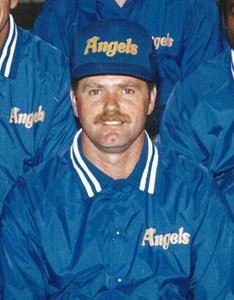 Art Stevenson: I told “Olly”, who was the player-coach of the fastball team at CFB Kingston that I had decided not to play in 1987. Bill is a unique individual, who had a real passion for the game. I enjoyed working for him on the athletic staff because I always knew where I stood. He was well known for his tough love.
Art Stevenson: I told “Olly”, who was the player-coach of the fastball team at CFB Kingston that I had decided not to play in 1987. Bill is a unique individual, who had a real passion for the game. I enjoyed working for him on the athletic staff because I always knew where I stood. He was well known for his tough love.
He tried to convince me to play (as a pitcher), but I resisted. At one point, he pointed his finger at me and said, “I’ll tell you what, if you can beat me in tennis, I’ll leave you alone. If I win, you play ball this summer.” I appreciated Bill’s passion and I gladly took what I considered a ‘sure bet’. Since I was quite a bit younger than him, very fit and a good tennis player, I figured that I could beat `the old fart` then well into his 40s. He had the wimpiest serve you ever saw. And his returns were pathetic, lacking both pace and style. The trouble was that the ball kept coming back at me. No matter how hard or where I hit it, the darn thing kept coming back over the net. As it turned out the tennis match was not even close.
I ended up playing base team fastball that year. We won the Ontario Regions! We had a three week break before the Nationals. I had previously scheduled a two week holiday to Florida with the family – much to the chagrin of Coach Oliver. He mentioned later – “Art, during the regional play-offs, your pitches looked like an aspirin to the opposing batters; when you returned from your Florida holiday – the pitches looked more like the size of pillows…”
Needless to say, when we went off to Moose Jaw for the Nationals, I was hit all over the place! We lost. He still reminds me of the ’87 Nationals and my summer trip to Florida every chance he gets!
Art may be reached: 506 357-6692 artanddiane@rogers.com
Note: All three interviews were carried out by E3161 Victoria Edwards (RMC ‘03).

